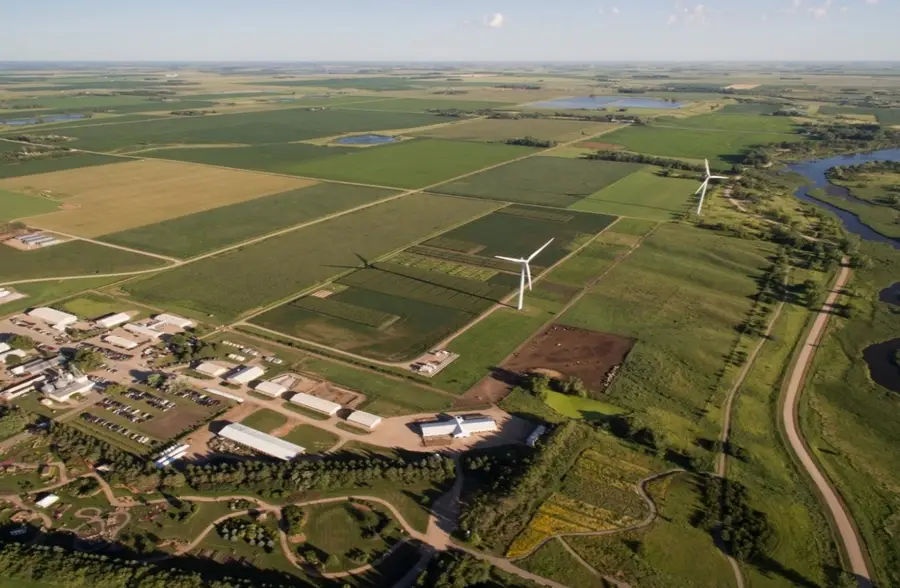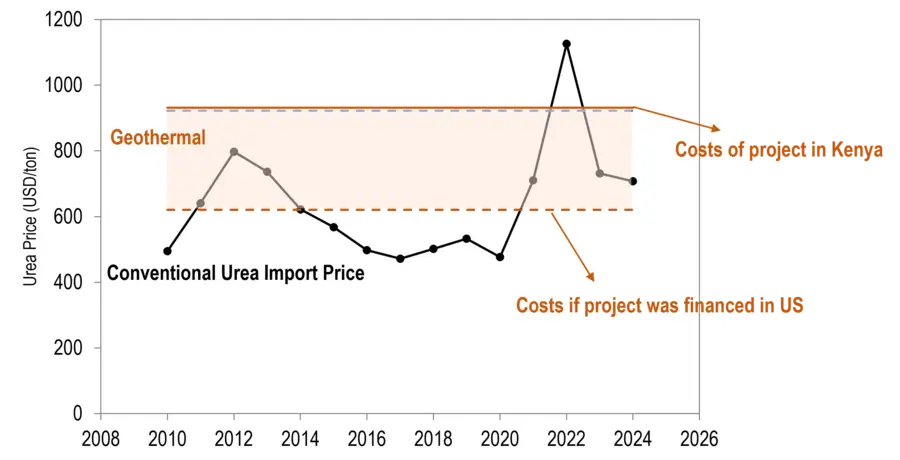Assessing the Viability of Green Fertilizer Production in Africa
Image courtesy of the University of Minnesota’s West Central Research and Outreach Center.
RTI uses cookies to offer you the best experience online. By clicking “accept” on this website, you opt in and you agree to the use of cookies. If you would like to know more about how RTI uses cookies and how to manage them please view our Privacy Policy here. You can “opt out” or change your mind by visiting: http://optout.aboutads.info/. Click “accept” to agree.

Image courtesy of the University of Minnesota’s West Central Research and Outreach Center.
Improve Africa’s food security, reduce economic vulnerability, promote green industrialization, and drive renewable energy expansion through domestic production of green fertilizers.
Assess the technological and economic viability of green fertilizer production in four African countries that have robust renewable energy portfolios and/or strong public support for green energy, in comparison to imported fossil fuel-derived fertilizer prices.
Identify promising locations and renewable energy resource combinations for pilot deployment of green fertilizer production facilities in Ethiopia, Kenya, Nigeria, and Morocco and provide project developers, industry, financiers, and policymakers with new data to inform green industrial growth.
Approximately 70% of the world’s ammonia is used to manufacture the fertilizer needed for high crop yields, but traditional production methods rely on fossil fuels and generate extensive greenhouse gas (GHG) emissions that contribute to climate change. Green ammonia holds great potential to decarbonize agricultural industries and drive renewable energy deployment.
Africa is endowed with vast renewable energy resources to potentially produce green fertilizers. Domestic production of green ammonia could help many African countries ease their dependence on imported fertilizers as they simultaneously seek to improve agricultural yields to increase food security. At the 2024 Africa Fertilizer and Soil Health Summit, government delegates endorsed the Nairobi Declaration tripling domestic fertilizer production by 2034.
Green ammonia could also accelerate renewable energy deployment in Africa because it serves as an energy carrier, supporting the long-duration storage needed to overcome the natural variability of electricity derived from wind and solar resources. For that purpose, it is superior to hydrogen, which is more difficult to store and transport.
Building on its green ammonia technology development in the United States, RTI internally funded and conducted a highly innovative research and modeling study to assess the technological and economic viability of producing green ammonia and low-carbon urea in four African countries.

The site of the RTI-led Next-Generation Green Ammonia Technology Demonstration at the University of Minnesota’s West Central Research and Outreach Center in the U.S. Image courtesy of the University of Minnesota’s West Central Research and Outreach Center.
This study is highly novel for multiple reasons. We took an optimization-based approach that employs advanced systems engineering for chemical production from variable renewable energy. To ensure relevance to the target geographies, our study used localized data in relation to fertilizer consumption and prices; renewable energy resources; the costs of renewable energy project development, labor, and transport; and water risks. To achieve realistic and accurate results, we also used comprehensive renewable energy project development costs from projects recently commissioned, under construction, or planned.
Our modeling, conducted in partnership with Power-to-X Analytics, determined the levelized costs of producing green ammonia (LCOA) and low-carbon urea (LCOU) from variable renewable energy based on hourly generation data, as well as purchased green electricity. The model determines the optimal tradeoffs between (i) battery storage capacity for electricity storage, (ii) hydrogen and nitrogen storage capacity, and (iii) oversizing of flexible chemical production, which can adjust its production rates in response to variability in renewable generation.

Unit-by-unit flowsheet for green ammonia and urea production from the clean power sources analyzed.
We modeled scenarios in four countries, including wind/solar hybrid, geothermal, and purchased green power in Kenya; geothermal and purchased power in Ethiopia; wind/solar hybrid in Nigeria; and wind/solar hybrid in Morocco. We also modeled small-scale and large-scale production based on historical fertilizer import quantities.
We selected the locations and scenarios based on their renewable energy resources and the industry’s maturity, regional power trade, the availability of fertilizer data and market insights, the amount of fertilizer imported, climate-related water risks, the existence of enabling environments to support the production of green hydrogen and its derivatives, and signs of investor activity.
Our analysis indicates that Kenya and Ethiopia are best-positioned to leverage available renewable resources such as wind, geothermal, and hydropower to meet their domestic urea needs. Our results also highlight some major challenges for implementing novel technology solutions in these countries. We find that though these solutions are technically viable, the cost of accessing capital in these regions is a major barrier.
In the figure below, we compare the price of imported urea (in black) to the modelled cost of domestically produced urea. We project that if the facility were in the U.S., with certain standard interest rates for green hydrogen projects, urea costs would be much lower than current imported costs. However, the costs of capital access are more than two times higher than the U.S. This difference leads to an almost 40% increase in levelized costs of urea production in the geothermal example below. The cost of capital has similar impacts for fertilizer production from other renewable resources as well.

Effect of cost of capital on production costs.
It is important to emphasize that green fertilizer projects are technically viable in Sub-Saharan countries with strong renewable energy resources, as the technologies continue to mature. The elevated production costs modeled are financial barriers. The good news is that financial barriers can be addressed through policy interventions, the reduction (or elimination) of subsidies for imported fossil fuel-derived fertilizers, and the adoption of regulatory incentives that support green industrial production, with a particular emphasis on policies and regulations that lower renewable energy costs. We must also consider that in a carbon-constrained world, carbon pricing mechanisms will inevitably make traditional ammonia and its derivatives less cost-competitive.
In addition, to make green fertilizer project development viable in low- and middle-income countries, it is necessary to attract concessional development finance to lower and de-risk the cost of capital. Such finance may come as grants or technical assistance to cover early-stage project preparation, low-interest loans with longer and more flexible repayment terms, first-loss debt, guarantees, political risk insurance, currency exchange protection mechanisms, or other forms.
To attract concessional development finance, it is imperative to account for both the costs of green fertilizer production, as analyzed in this study, and the developmental benefits. These benefits include lowering the reliance on imports (cash outflows), reduced food insecurity through the application of domestically produced fertilizers, building a workforce catering to green higher-paying jobs, development of local content green industrial supply chains, investment in the domestic economy, and reduced GHG emissions, among others. Considering both costs and benefits can frame policy and financial support for green fertilizer development as a no-regret sustainable development choice.
RTI continues to conduct further research to quantify these benefits and engage with relevant stakeholders to ensure that technological advances and knowledge can be turned into practice for the global good.
Learn more about the potential of green ammonia in clean energy storage and mitigating climate change across Africa.